Radar is getting hot, especially with advancements that promise object identification/classification and higher latitude resolution — something traditional radars couldn’t do. With these new innovations, radars are emerging as the most sought-after sensor among carmakers and Tier Ones developing highly automated vehicles. Responding to the high expectations of the automotive industry, NXP Semiconductors announced on December 7th that it is sampling a suite of new radar sensor chipsets, consisting of the company’s S32R45 radar processor and new 77GHz transceivers called TEF82xx.
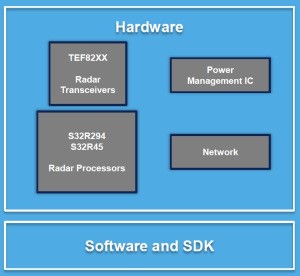
NXP’s new radar sensor chipsets solution (Image: NXP)
NXP, which pioneered RF CMOS radars with its first radar chip called “Dolphin” five years ago, has been a leading automotive radar solution supplier.
NXP’s 4D imaging sensors can measure not only range and speed, but also “elevation, direction, and angle of arrival, while identifying objects at a much higher resolution,” explained Torsten Lehmann, executive vice president and general manager for radio frequency processing, during an interview with EE Times. With 4D imaging radar that can understand not only the horizontal but also vertical planes, a vehicle can, for example, determine whether to drive “underneath” or “over” an object, said Lehman.
“Picture a scene when a vehicle is driving at 80 kilometers per hour on a highway, while a motorcycle — a small object with low reflectivity — is coming from behind at 200 kilometers per hour” he said. Unlike cameras and lidars, these new improved radars can identify the motorcycle, initially far apart, and recognize these two objects are moving at two different speeds, explained Lehmann.
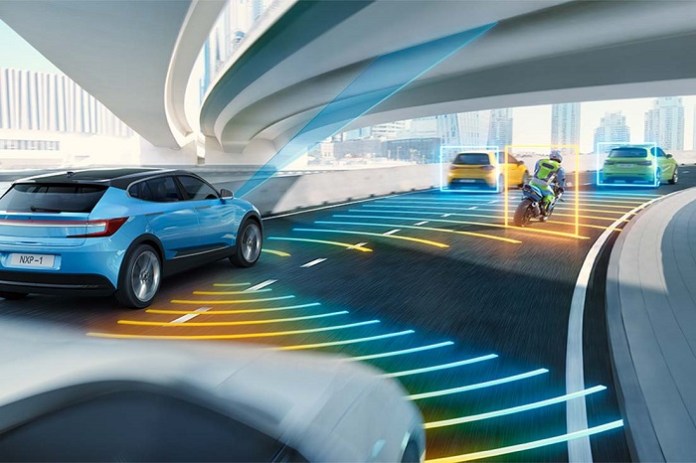
(Image: NXP)
Thus far, radar has been the only sensor capable of operating in excess of 300 meters, recognizing objects running at high speeds. Neither cameras nor lidars can handle that much distance and speed.
With the emergence of higher resolution imaging radars, many radar suppliers, including NXP, are eager to elevate radars as the only high-speed sensor able to function in the worst of weather and lighting conditions.
Scalability
NXP is hardly alone in talking about 4D imaging radar. Continental announced last September that it is using Xilinx FPGAs to deploy the automotive industry’s first production-ready 4D imaging radar, expected to ship in passenger vehicles in 2021.
Given NXP’s volume production experience with 77GHz RF CMOS transceivers, and its S32R45 radar processor, NXP claims its 4D imaging radar chip set can substantially reduce cost and power efficiency compared to general-purpose FPGA implementation. NXP, however, refrained from specifying the degree of cost/power reduction.
Phil Magney, founder and the president of VSI Labs, told us, “We have been closely following this space for some years now. Ironically, the first time I heard about it was from an NXP presentation some years ago. At that time, it was presented as a potential competitor to lidar as the new radars could produce a point cloud.”
Obviously, NXP has been plotting its 4D imaging radar launch for some time.
But NXP’s pitch is shifting. Instead of just talking up its ability to produce point clouds, the company’s emphasis has now moved to the scalability offered by a suite of its new radar solutions.
NXP now touts “a common platform that scales across different use cases,” ranging from corner radar and long-range front radar to imaging radar. This is important to an industry seeking technologies to clear the New Car Assessment Program (NCAP) requirements demanding the better performance in blind spot and automatic emergency braking features. While NCAP does not specify preferred sensor technologies, carmakers — pressed to meet NCAP requirements — are shopping for better radar technologies that can detect objects in corner and front, explained Lehmann.
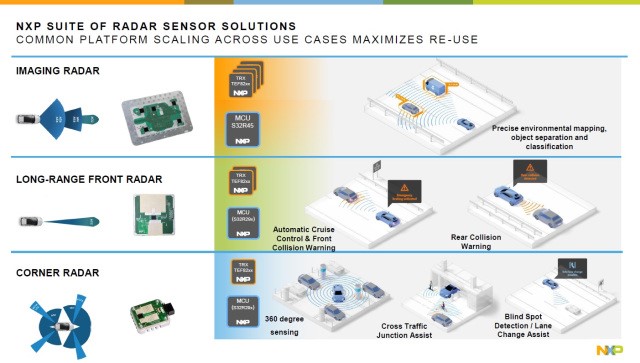
NXP’s radar sensor chipsets consists of corner radar, front radar and 4D imaging radar. (Image: NXP)
For blind spot detection and lane assist in Leve1 and 2 vehicles, a combination of NXP’s single TEF82xx transceiver and S32R45 radar processor works. The addition of automatic cruise control and front and rear collision warning to L2 and L3 cars would require two transceivers instead of one. For object separation and classification demanded by L4 and L5 autonomous vehicles, OEMs can combine four cascading transceivers with one radar processor.
The key is that throughout the transition to higher automation, carmakers who must address diverse brands and models should be able to use a single platform designed to re-use software and hardware.
Transition to 4D imaging radar
The evolution of automotive radars, however, is muddled by marketing jargon.
Traditional radars — sometimes called 2D — transitioned as imaging radars. “Imaging radar essentially creates an array whereby the density of measurements increases dramatically,” explained Magney. “Traditional 2D radar is coarse by comparison and only produces a single point per object. But an imaging radar would produce many points to better understand what is being tracked.” To sum up, he noted, “Imaging radar produces vertical resolution whereby traditional radar works off a single plane.”
How then are 3D and 4D imaging radars different?
“I think time is being used at the fourth dimension. I have heard this from a few other companies as well and this is how they use it,” noted Magney. But he added, “Honestly, 4D is more marketing hype than anything else, because the time element is derived from Doppler. So, if this were the case, then, traditional 2D could be called 3D.”
In other words, the time element has always been critical to what radars offer. Asked the same question, NXP’s Lehman noted that the fourth element of the 4D imaging sensor is “lateral resolution.” 4D imaging radar grasps the environment better, determining whether a vehicle can fly under or over an object.
Latitude resolution
“Higher latitude resolution” translates into greater vertical resolution, noted Magney. “This in itself is one of the more important features.”
This discussion evokes the Joshua Brown case. Brown’s Tesla Model S sedan killed the driver, colliding with a tractor-trailer crossing his path on US highway 27A in Florida in May 2016. It’s widely reported that the Tesla, equipped with cameras and traditional 2D radar, assumed the car could go under the giant rig, and drove straight into it.
Could a 4D imaging sensor have prevented such a fatal accident? Magney said, “Yes, this type of radar would not be prone to false positives coming from traditional radar. And it would not have permitted the Tesla accident.”
Higher performance transceivers and radar processing
NXP’s new TEF82xx – 75mm x 75mm – is built on its second-generation RFCMOS based on 40nm process technology. The company claims it can double RF performance for enhanced sensing, when compared to the previous version.
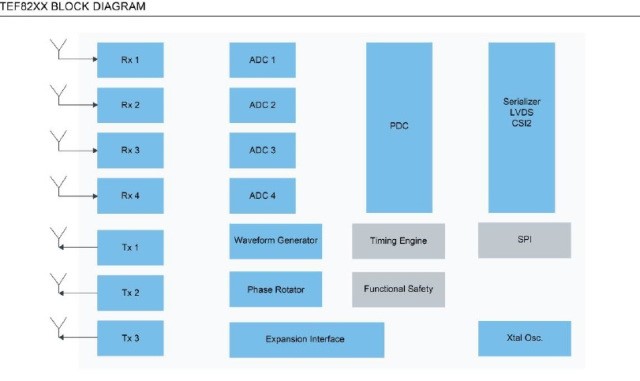
TEF82xx block diagram (Image: NXP)
The new transceiver chip also offers 4X phase noise reduction around target, making it possible to offer better object separation. It comes with a 6-bit phase rotator for beam steering applications and advanced modulation MIMO support.
NXP’s new S32R45 radar is built on 16nm FinFET process. It offers up to 4X cascade transceiver support for “precise environmental mapping and enhanced scene understanding” in L4 and L5 vehicles, the company claimed.
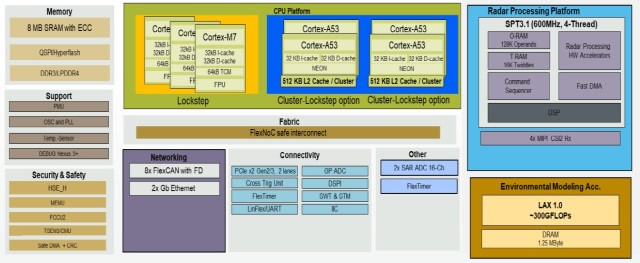
S32R45 block diagram (Source: NXP)
It’s important to note that S32R45 is capable of novel radar accelerations. More specifically, it offers new “linear algebra radar accelerator” providing up to 64X performance compared to an ARM A53 core, according to NXP. This translates into running “super-resolution direction of arrival (DoA) algorithms and true MIMO operation even in adverse weather conditions,” NXP claimed.
Renewed debate: lidar vs. radar
NXP claims that its new 4D imaging radar offers lower than 1-degree angular resolution. But how does it compare to lidar?
Lehman noted, “If you are talking about a high-performing lidar — like a mechanical rotating kind used by Waymo, it can produce much granular point clouds, since it offers lower than 0.1° or 0.5° angular resolution.” He added, but such a lidar is “bulky and costs thousands of dollars.”
Magney observed, “There is a rumor that Tesla is considering imaging radar for the model 3 platform and this would be a good move, because it provides a better answer for not using lidar.” System Plus Consulting’s teardown revealed that Tesla used Continental’s 2D radar, as reported by EE Times.
However, according to Magney, Tesla has switched from Continental to Bosch for greater range. He explained that these are both 2D radars with the limitations of traditional radars. “As far as I am concerned, a move to imaging radar by Tesla would be shrewd. Understand that imaging radar produces a point cloud. Even though it is of lower resolution than Lidar, [still] it is a huge improvement over traditional radar,” said Magney.
In summary, though, Magney stressed, “I am not about to throw lidar under the bus just yet.”
In his opinion, lidar has a huge advantage over radar now, even though that gap might be closing with the new radars. “One of the key applications for lidar is its ability to perform relative localization against a base map. This is vital for urban robotaxis and shuttles and I don’t think you could displace lidar for this task.”
Magney concluded, “Lidar won’t go away even as 4D radar comes along. Rather than displacing lidar, you could say the new radars overcome some of the limitations of traditional radar.”
Availability
NXP’s new radar sensor chipsets will roll out in 2021. The new radar chip set, sampling today, will go to volume production in 2021. Corner radar, front radar and 4D imaging radar will be released over several months in 2021, but all three will become available in the second half, said Lehman. He declined to comment on pricing.
The NXP radar sensor chipsets article originally published on sister publication EE Times.
Advertisement
Learn more about NXP Semiconductors





